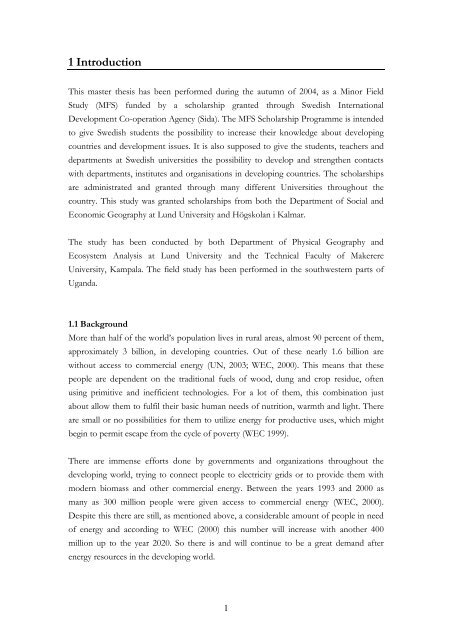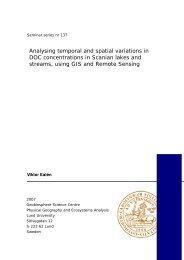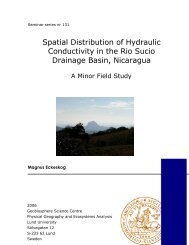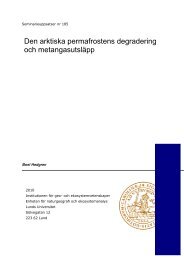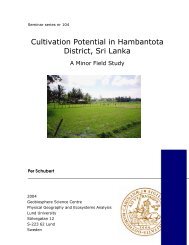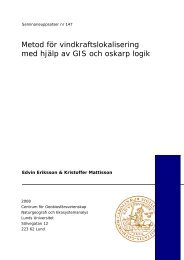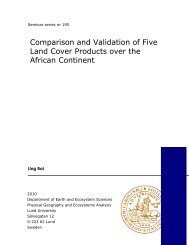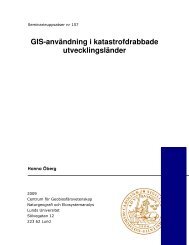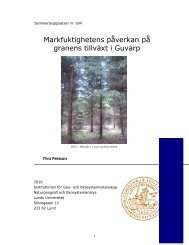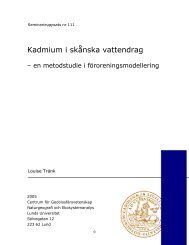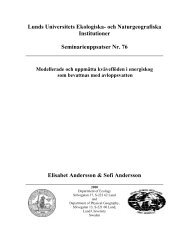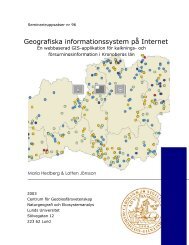Finding Potential Sites for Small-Scale Hydro Power in Uganda: a ...
Finding Potential Sites for Small-Scale Hydro Power in Uganda: a ...
Finding Potential Sites for Small-Scale Hydro Power in Uganda: a ...
You also want an ePaper? Increase the reach of your titles
YUMPU automatically turns print PDFs into web optimized ePapers that Google loves.
1 IntroductionThis master thesis has been per<strong>for</strong>med dur<strong>in</strong>g the autumn of 2004, as a M<strong>in</strong>or FieldStudy (MFS) funded by a scholarship granted through Swedish InternationalDevelopment Co-operation Agency (Sida). The MFS Scholarship Programme is <strong>in</strong>tendedto give Swedish students the possibility to <strong>in</strong>crease their knowledge about develop<strong>in</strong>gcountries and development issues. It is also supposed to give the students, teachers anddepartments at Swedish universities the possibility to develop and strengthen contactswith departments, <strong>in</strong>stitutes and organisations <strong>in</strong> develop<strong>in</strong>g countries. The scholarshipsare adm<strong>in</strong>istrated and granted through many different Universities throughout thecountry. This study was granted scholarships from both the Department of Social andEconomic Geography at Lund University and Högskolan i Kalmar.The study has been conducted by both Department of Physical Geography andEcosystem Analysis at Lund University and the Technical Faculty of MakerereUniversity, Kampala. The field study has been per<strong>for</strong>med <strong>in</strong> the southwestern parts of<strong>Uganda</strong>.1.1 BackgroundMore than half of the world’s population lives <strong>in</strong> rural areas, almost 90 percent of them,approximately 3 billion, <strong>in</strong> develop<strong>in</strong>g countries. Out of these nearly 1.6 billion arewithout access to commercial energy (UN, 2003; WEC, 2000). This means that thesepeople are dependent on the traditional fuels of wood, dung and crop residue, oftenus<strong>in</strong>g primitive and <strong>in</strong>efficient technologies. For a lot of them, this comb<strong>in</strong>ation justabout allow them to fulfil their basic human needs of nutrition, warmth and light. Thereare small or no possibilities <strong>for</strong> them to utilize energy <strong>for</strong> productive uses, which mightbeg<strong>in</strong> to permit escape from the cycle of poverty (WEC 1999).There are immense ef<strong>for</strong>ts done by governments and organizations throughout thedevelop<strong>in</strong>g world, try<strong>in</strong>g to connect people to electricity grids or to provide them withmodern biomass and other commercial energy. Between the years 1993 and 2000 asmany as 300 million people were given access to commercial energy (WEC, 2000).Despite this there are still, as mentioned above, a considerable amount of people <strong>in</strong> needof energy and accord<strong>in</strong>g to WEC (2000) this number will <strong>in</strong>crease with another 400million up to the year 2020. So there is and will cont<strong>in</strong>ue to be a great demand afterenergy resources <strong>in</strong> the develop<strong>in</strong>g world.1


